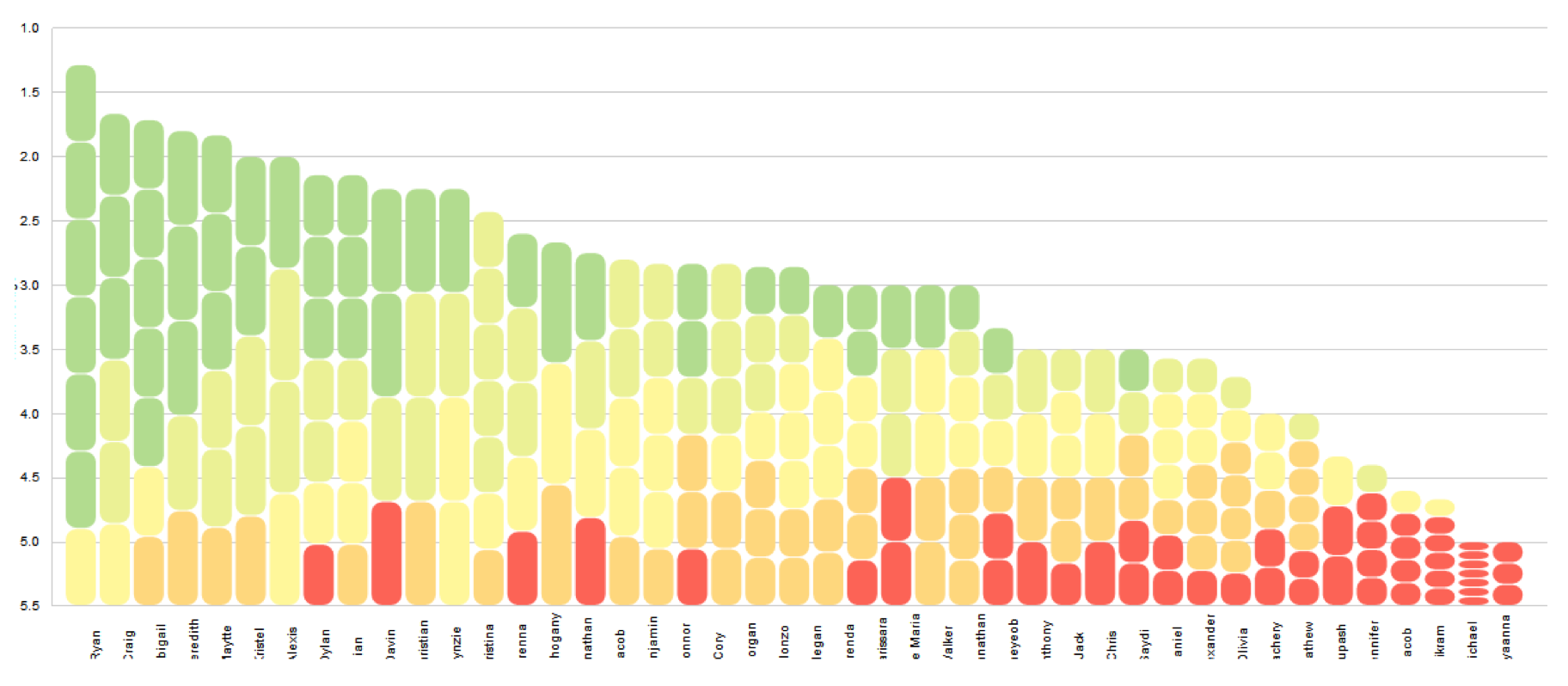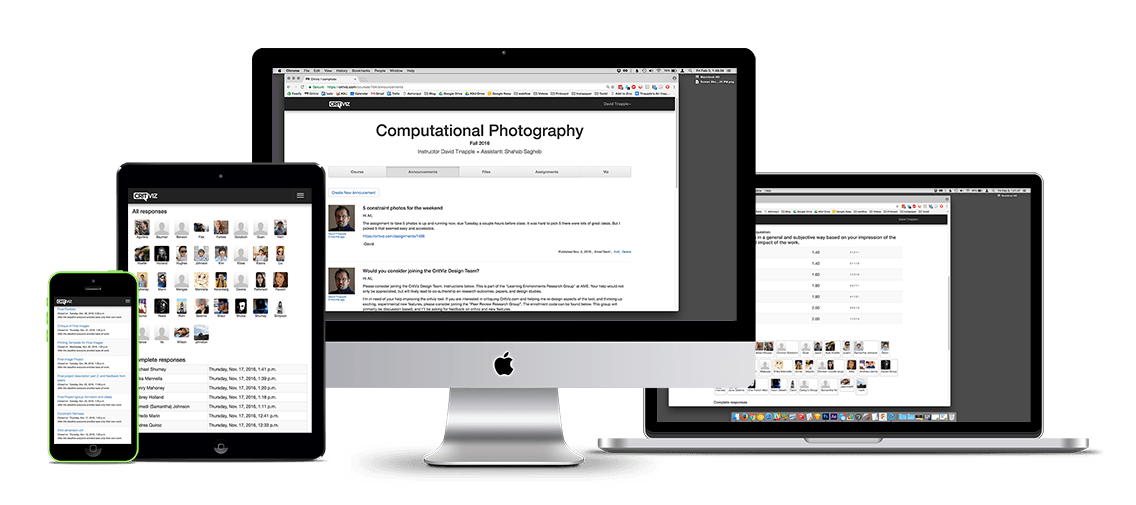What is CritViz?
CritViz is a web-based tool for classrooms, designed to support the practice of student peer-critique. It works in large and small courses, for any subject, online or in-person. Ordinarily, peer-critique sessions are practiced in classrooms that are small enough to sustain a single discussion. CritViz was built to facilitate student peer-critique sessions in large classes. It works for small classes just fine too!
CritViz allows instructors to create deadline-based assignments, where students can submit large files securely. It is optimized to support rich multi-media including photos, videos, audio files, rich text documents and more. After assignment responses are collected, CritViz allows instructors to create critique-assignments where each student is asked to provide feedback to a random subset of peers (the number of items is optional). This feedback can take the form of writing, voice, or video responses, and the instructor can optionally include ratings and ranking scales. CritViz can be used from any web-enabled mobile device, desktop, or tablet computer.
Why use it?
When students engage in the social activity of giving and receiving feedback, they engage with the work and their own learning process more deeply than if they were trying to simply maximize their grade with minimal effort. Peer-review changes the social and motivational structure of the class, giving students a central role in determining what work deserve attention. (see Topping, 2009)
“Critique is a feedback system based on the principle that the best possible outcome from a response session is for the maker to want to go back to work.”
Why Critique?
Formal critique can be a powerful teaching tool. In many kinds of classes, there are times when student work cannot be evaluated on entirely objective criteria. Sometimes there is no clear right or wrong answer. By asking students to formally review and respond to the work of peers, the instructor is simultaneously creating an atmosphere of social learning, and asking the students to engage in "meta-cognitive" thinking about the work at hand. This benefit is clear even when beginners write reviews that aren't very helpful to the recipients. This simple act of openly discussing and reviewing work can have tremendous impacts on the learning process.
“Critique is an essential element in the process of knowledge construction. In short, knowing why the wrong answer is wrong in academic discourse can be just as important as knowing why the right answer is right.”
How does it work?
CritViz allows an instructor to create assignments with deadlines. Assignments consist of questions that prompt students to respond in specific ways (by uploading text, video, image, sound, or files). Instructors can customize their assignment by adding instructions followed by any number of these question prompts. It's simple to create assignments that are readings, essays, papers, videos, large projects, and quick surveys. Students know exactly what is required and what the deadline is.
After an assignment deadline arrives, the instructor can create a follow-on "critique assignment" where students are asked to review and respond the work of their peers. Similar to a standard assignment, these "critique assignments" also consists of questions that prompt the students to respond in specific ways (text, video, image, sound, file), but critique assignments can also include rankings and ratings of peer work.
In a Critique Assignment, the instructor determines how many reviews each student is assigned to complete. Student's responses to their peers work can be anonymous or named, and can be private to the recipients, or public to the class.
CritViz can visualize the results of critique sessions, showing students how they performed in a critique relative to their peers. (Below see the critique analysis graph, allowing instructors and students to visualize relative critique ranking scores on an assignment)

Why isn't CritViz free?
CritViz was created and is run entirely by a group of professors who use it every day in their classrooms. Our goal is to create a tool that delivers value for students and teachers. (If administrators and investors like it too, that's nice). We continually elicit feedback from enthusiastic users and make changes when we think it will create a better tool. We feel that "better" is best measured not by how much user time, activity, and attention we can capture, but by how engaged students are with difficult concepts, and how empowered professors are to create powerful learning experience. If CritViz were free, it would mean that value would need to be created primarily for someone else (typically advertisers) and so the users of CritViz would become the "product" being sold. We aim to simply pass along costs of running the service (bandwith and storage) directly to those who find value in using it (students and teachers). You will never see an advertisement on CritViz, and we will protect your data (and meta-data) with great care.
Instructors: How to get started?
If you are an instructor and want to get started using CritViz, you can create your first CritViz course for up to 30 students using our free trial. The trial can only be used once to create one course. The course can last up to a year and enrollment is limited to 30 students and 1 Gigabyte of disk space, but is otherwise identical to the paid plans. To get started, simply create your CritViz account by clicking the "create new account" at the top of this page. Verify your email address by clicking on the link you should receive in your email, then sign-in to CritViz. Once signed in, you can find the "create course" button under your name in the menubar at the very top of the screen. This will start the guided process of creating a free trial course, or a course under a paid plan.
Students: How to get started?
If you are a student and want to enroll in an instructors CritViz course, simply create your CritViz account by clicking the "create new account" at the top of this page. Verify your email address by clicking on the link you should receive in your email, then log-in to CritViz. If the course you want to enroll in is administered by a "Free Trial", "Instructor", or "Instructor Pro" plan, then enrolling in the class will be free for you. You will not be asked to enter payment information. If the course is administered under a "Student Activated" plan, you will be asked for one-time payment information. In either case you will need to be either manually enrolled by the instructor (where the instructor enrolls you via your email address), or you will be given an "Enrollment Code", which you can use to enroll yourself.
Subscription Plans
Free Trial
Try it today.
No credit card required.

Free for Everyone

Up to 20 students

Unlimited Assignments

Unlimited Critiques

Unlimited Email

1 Gigabyte Storage

Six Months Limit
Instructor
per month, per class

Free for Students

Up to 50 Students

Unlimited Assignments

Unlimited Critiques

Unlimited Email

20 Gigabyte Storage

One year instructor archive access after course ends.

Upgradable to "Instructor Pro"
Instructor Pro
per month, per class

Free for Students

Up to 150 students

Unlimited Assignments

Unlimited Critiques

Unlimited Email

40 Gigabyte Storage

One year instructor archive access after course ends.
Student Activated
per month, students pay once, at enrollment, for access to course

Free for Instructors

Unlimited students

Minimum 6 month duration

Unlimited Assignments

Unlimited Critiques

Unlimited Email

100 Gigabytes storage

One year student and instructor archive access
Site Licenses
If you have tried CritViz and would like to make it a part of your department, school, or university, give us a call or send us and email. We are happy to work with you to find a solution for giving all your instructors and teachers unlimited access.
Bigger is better?
Why can't "Bigger is Better" apply to classrooms? Can a 100 person class be better than a 30 person class? In everyday life we normally see benefits when networks grow large. Online social networks usually improve with scale, as do economies and businesses. So why do we still almost universally assume smaller classes are better than larger ones? With networks, bigger is usually better. Classrooms however are rarely designed as networks. Computer supported peer-review changes this classroom structure.
When student peer-review becomes central to the course structure, something interesting happens. Bigger classes start becoming more interesting, and more effective than smaller ones. When computers help manage the peer-review process, the addition of more students to the classroom no longer represents a drain on resources but instead increases value. Larger classes lead to more diversity, more feedback, and more points of view. CritViz uses computer connectivity to create new kinds of classroom structure, giving instructors new kinds of leverage that takes advantage of the diversity of large groups.
Does using CritViz make it "easier" to teach a large class? It depends. We prefer not to think only in terms of instructor efficiency, but also in terms of new kinds leverage. Teachers may or may not spend less time on teaching when using CritViz, but they will probably spend that time doing things that are far more interesting, that deliver more value to students, and that lead to better learning outcomes.



































